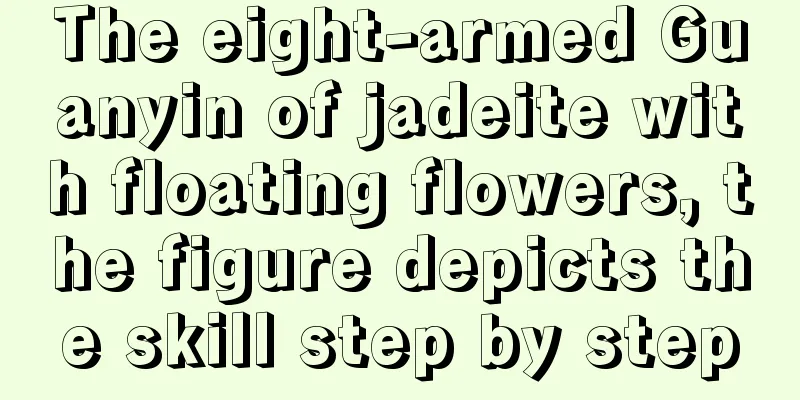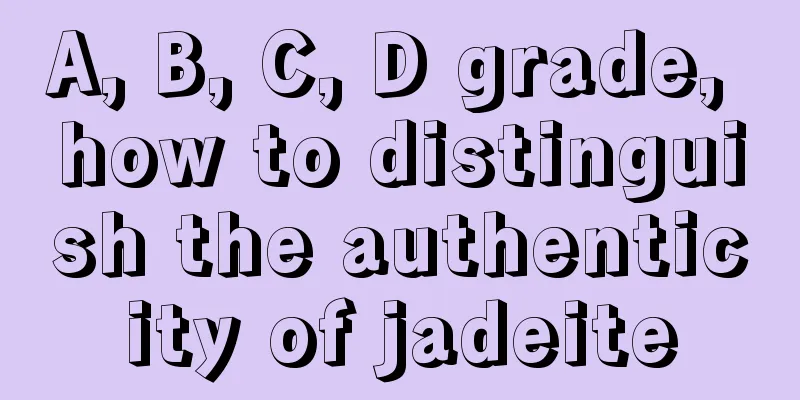The eight-armed Guanyin of jadeite with floating flowers, the figure depicts the skill step by step

|
Rough Stone By chance, I found a piece of ice-type jadeite with floating flowers. Initially, this piece of jade was intended to be carved into a landscape plaque. Look at the landscape outlined on it, is it an impressionistic landscape painting? At the same time, it was once designed with Taihu stones, bamboo and lotus leaves. The water quality of the material was very poor before, but after adjusting the water, the effect of the finished product was in stark contrast. After some consideration, I decided to change my thinking and made an eight-armed Guanyin combined with inlay. It is designed into the shape of lotus petals according to the shape of the card. After the plastic surgery design Design is actually very critical because it is directly related to the entire structure and effect in the later stage. The design features an eight-armed Guanyin standing on a lotus, symmetrically arranged according to proportion, but the Buddha's hands and instruments are different. Carving·Rough According to the design, a bas-relief was made and a rough blank was chiseled out. Carving and polishing The large chiseled piece was polished, becoming more and more three-dimensional, and the whole began to emerge. The most critical step is to open the face. This step is related to the success or failure of the work and is left to the last step. Generally, the face of Guanyin is dignified and compassionate. The Buddha should always smile and be honest and kind. Some carving masters may accidentally make the character's face look lifeless or a bit "fierce", and even if the material is good, the price will go down. Because Buddhists believe that only tasks with a kind face will bring good luck, otherwise the opposite. Among them, the labor cost of Guanyin is the most expensive, because the charm of Guanyin is all in the face, which actually requires relatively high labor. Master Lin is well-known in the industry for his expertise in carving the faces of Buddha statues. With years of intensive research and accumulation, he is very adept at handling Buddha statues. Despite this, Master Lin is very rigorous when carving the faces of Buddha statues. Let's take a look at the effect after polishing the face. The jade is warm and delicate, with a quiet color and a strong gum texture. The overall work is dignified and majestic, with smooth lines, a clear theme, a strong sense of three-dimensionality, and a prominent aura, showing dignity and grace. The compassion and smile of Guanyin create affinity and a sense of peace of mind. The overall polishing process makes the work more shiny and soft. In fact, the design of the back is also very particular, and it strives to echo the content on the front, so it is designed to be the mantra of Avalokitesvara Bodhisattva, that is, the six-syllable mantra "Om Mani Padme Hum" in Chinese characters. However, other solutions were designed before this, as shown in the figure: This is the finalized plan: According to the final design, wax carving and inlaying are carried out. However, such an inlay process takes at least one week. - Mosaic setting draft - Work completed Eight-armed Guanyin Author: Lin Qiuping In the eyes of Chinese Buddhists, the Eight-Armed Avalokitesvara is a great bodhisattva with strong responsiveness and great care for his worshippers. She is also the mother of all Buddhas of the three ages. She has immeasurable blessings and wisdom, vast merits, and deep responsiveness. In order to satisfy all worldly and transcendental wishes of sentient beings, she entered into the Cundi Samadhi, recited the Cundi Mantra spoken by the past seven kotis of Buddhas, and guarded all sentient beings meticulously. The Eight-Armed Guanyin symbolizes being versatile and having great magical powers. The six-syllable mantra "Om Mani Padme Hum" is engraved on the back, echoing the theme. Guru Padmasambhava once said: The essence of all eighty-four thousand dharmas is this six-syllable mantra! Whoever recites this mantra will obtain extraordinary achievements, has the power to eliminate sins, and perfect the supreme virtue. Once the sentient beings in the six realms hear it, they will be able to escape from the evil realms and obtain the three good realms or even liberation. Whoever can recite one sentence of the six-syllable mantra will surely walk towards the path of Bodhi! fcgc66 fcgc99 |
<<: Jade Appreciation | Full of holes and yet breathtakingly beautiful
>>: What types of jade patterns are there?
Recommend
What kind of jade has rigidity?
The first type: old jade Old jade has high densit...
How high a temperature can jadeite withstand?
In some tutorials on jade identification , some p...
Four methods to identify C-grade jadeite
As we all know, C-grade jade is a product of arti...
Hetian jade processing
my country has a long history of mining and utili...
Playing with jade allows us to calm down and enjoy the beauty of life
In today's fast-paced era, many people may ha...
Do you know the four major "schools" of jade carving?
Jade cannot be made into a useful object without ...
Jadeite Cutting Class: There are colorless and high-grade jadeite
There is a saying in the jade industry: Jade with...
How to Choose Violet Jade
When it comes to violet jadeite, there is a sayin...
Can I still wear jade that has been worn by others?
In the eyes of Chinese people, jade is full of sp...
Peculiar, niche and tasteful: Appreciation of jadeite carvings with beautiful colors
There are many kinds of jade carving techniques. ...
Are you still confused about the difference between purple chalcedony and violet? Teach you a few tips to avoid buying the wrong
In the jade market, there is a beautiful landscap...
At first, the black jadeite was mixed with the black jade and it was difficult to tell them apart. God said: Let there be light!
Black jadeite is a type of jade. Except for the c...
Easily master the distinction of jade quality and water, no longer confused when purchasing
Jade, the gem of the East, shines brightly and at...
Have you ever seen a million-level sky blue emerald?
As we all know, jade is known as the "one hu...
Which type of jade should I choose to buy, a loose stone or a mounted finished product?
There is a saying in China since ancient times th...









